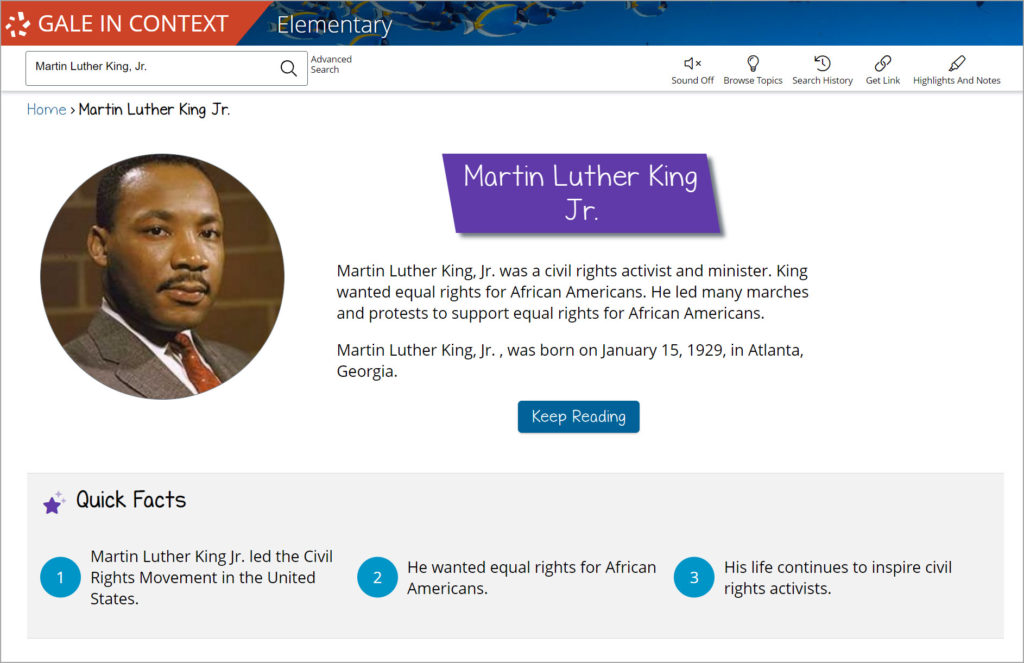| By Gale Staff |
A prominent leader in the American civil rights movement, Martin Luther King Jr. is remembered as an icon for social change and racial equality. We observe Martin Luther King Jr. Day every January to commemorate his life and the importance of his work.
Martin Luther King Jr. Day falls on the third Monday of January each year. It’s meant to celebrate the birthday of Martin Luther King Jr. on January 15th, though the date changes from year to year. Remembered for his work combatting unjust segregation in the American South using nonviolent principles, Martin Luther King Jr. was tragically assassinated in 1968. King’s wife, Coretta Scott King, petitioned for the United States to institute a national holiday in his name, and in 1983, she was successful. In honor of King’s legacy, MLK Day is now observed as a day for social change and volunteerism—a chance for Americans to serve and improve their communities.
Honor Martin Luther King Jr. Day in your classroom or library by educating students at every grade level about his legacy and his effect on the civil rights movement. You can discover engaging digital content to commemorate Martin Luther King Jr. with accessible, age-appropriate resources in Gale In Context.
Introduce Elementary Learners to MLK Day
Your younger students and patrons are still building their literacy and research skills, and the history of Martin Luther King Jr. can be a challenging but important subject to teach.
Elementary teachers and children’s librarians can take advantage of Gale In Context: Elementary for age-appropriate resources that introduce children to the legacy of Martin Luther King Jr. Gale provides comprehensive summary pages with bite-size sentences and helpful vocabulary assistance. The Martin Luther King Jr. Day summary immediately defines relevant terms such as “boycott” and “speech,” and the content is available in different reading levels.

Activity Idea: Have students find a quote from Martin Luther King Jr. and encourage them to create a piece of art that features his words. Hang up the art in your library space or classroom to celebrate MLK Day and Black History Month in February.
Integrate MLK Day Into Middle School Classrooms
Gale In Context: Middle School retains many of the helpful tools integrated into the elementary-level resources, but the content is designed for pre-teen learners. Middle school students can still find an accessible summary of Martin Luther King Jr.’s life with different reading level options, plus supplemental tools like timelines, key vocabulary, and embedded links for further research. Encourage them to explore King’s famous “I Have a Dream” speech and the March on Washington.
Gale’s digital content gives students the freedom to pursue their interests within a topic in a structured, scholarly environment.
Activity Idea: In the week preceding Martin Luther King Jr. Day, have each student choose a way to serve their community for the holiday from a list of service opportunities available in your town. After volunteering, have students write a short reflection on the experience.
Challenge High School Students to Consider Modern Civil Rights
Gale In Context: High School prepares teens for more rigorous study, encouraging them to think critically with more complex resources. Gale databases are frequently updated to match state and national curricular standards, which allows teachers and librarians to feel comfortable that students are accessing the most up-to-date, unbiased information.
While most high school students are aware of Martin Luther King Jr.’s history, they can learn more about the controversy surrounding the holiday in Gale In Context: High School.
High school students can also explore an in-depth collection on the civil rights movement in Gale In Context: US History. Connect students to resources that incite critical thinking, asking them to consider the purpose of Jim Crow laws and to brainstorm methods of nonviolent resistance.
Discussion Idea: Encourage students to search in Gale OneFile: News for a modern-day civil rights issue in the media. This could be in the United States or another country. Ask students to consider how people are organizing in response and what methods they’re using to protest current injustices.
K-12 teachers and school or public librarians can use Gale resources to access vetted, learning-friendly digital content to support lesson plans, library displays, and educational activities. If your classroom or library doesn’t subscribe to Gale resources, find your rep to get more information or to request a free trial.

